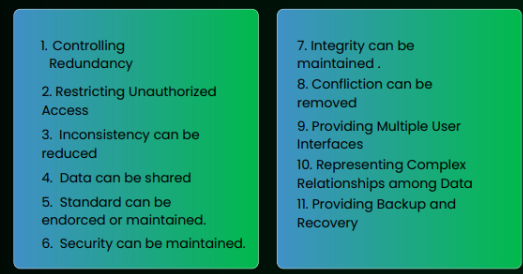DBMS
1/12
There's no tags or description
Looks like no tags are added yet.
Name | Mastery | Learn | Test | Matching | Spaced |
|---|
No study sessions yet.
13 Terms
DBMS
is a system software for creating and managing databases
provides users and programmers with a systematic way to create, retrieve, update, and manage data
a software through which users and application programs interact with a database
Data
smallest unit that may consists of bits or bytes
stored in a system is partition into one or two databases
can be collected orally or written
Hardware
a major and primary part of database
“which we can touch and see”, i.e. physical existence
Storage devices: hard disk, floppy disk, magnetic disk, magnetic drum
Software
a system that works together with hardware
System Software
OS, all the languages and system packages
designed to provide a platform for other software
act as an intermediary of hardware and user
Application Software
payroll, electricity billing, hospital management
created to help users to perform specific tasks directly
Users
individuals who interact with data to update, read, and modify information on a daily basis
work together with hardware
can access and retrieve data from database through DBMS applications and interfaces
Advantages of DBMS
Controlling Redundancy
Restricing Unauthorized Access
Inconsistency can be reduced
Shared Data
Standard can be endorced/maintaned
Security Maintenance
Integrity Maintanenance
Removed Confliction
Multiple User Interfaces
Complex Relationships of Data
Backup and Recovery

Disadvantage of DBMS
increased cost
Staff Cost
Complexity
Large Memory requirements
Database Failure
Difficult Backup and Recovery
Frequent Updates
Database Administrator (DBA)
Responsible for installing, configuring, upgrading, and maintaining databases.
System Analyst (SA)
Researches problems, plans solutions, and coordinates development.
DBMS Developers
Skilled systems programmers who develop and enhance DBMSs.
USERS
People who use the application and its interfaces but don't need to understand the underlying DBMS.